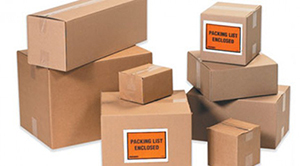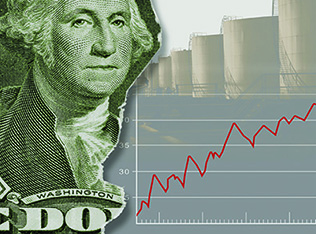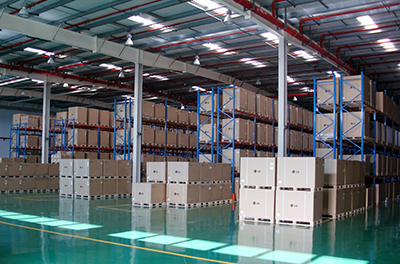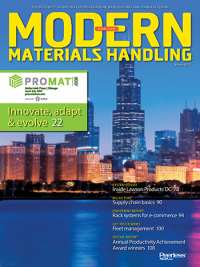Supply Chain Basics for Materials Handlers
Distribution center and warehouse managers who think they’re not in the center of the supply chain are kidding themselves. We talked to managers, consultants and academics about the supply chain processes most likely to impact DCs today.
Not so long ago, warehouses and distribution centers were focused on moving goods through a facility at the lowest possible cost. What happened outside the DC in the broader supply chain was, well, someone else’s problem.
That is beginning to change. Increasingly, activities and processes that take place outside the four walls of a building, ranging from sales and marketing plans to last-mile delivery, are impacting what happens inside the four walls.
“Customers want things faster, better and cheaper,” says George Prest, CEO of MHI, the organization that produces the ProMat and Modex trade shows.  “Our industry is at the heart of making that happen.” More importantly, the view of the warehouse and DC at the corporate level has changed. “Companies now talk about materials handling as a generator of revenue and having an impact on the bottom line,” Prest says.
“Our industry is at the heart of making that happen.” More importantly, the view of the warehouse and DC at the corporate level has changed. “Companies now talk about materials handling as a generator of revenue and having an impact on the bottom line,” Prest says.
Given this new role, we talked to five supply chain managers, consultants and academics about some of the basic supply chain processes that distribution center managers need to be aware of to do their jobs in today’s environment.
The customer is closer than you think: Supply chains are moving closer to the customer, both figuratively and literally. They are figurative in the sense that all processes are expected to deliver a higher level of customer service and personalization than ever before. Literally in that facilities are being built closer to the major urban centers, where a majority of a company’s customers live, augmented by fulfillment from stores and depots within those urban centers. “With two-day shipping being the norm, and next- and same-day delivery gaining in popularity, it’s like a tidal pull moving your link in the supply chain closer to the customer,” says Bryan Jensen, vice president and principal with St. Onge. “As such, we now refer to a distribution center as a fulfilment center, which is designed to be agile rather than massively productive.”
The evolution from distribution center to a fulfillment center has an impact on how facilities are designed to meet the customer service levels promised by marketing as well as last-mile delivery requirements, Jensen says.
For one, fulfillment centers store more SKUs than a conventional DC, but in lower quantities per item. Reserve storage is limited to evergreen products. Instead, inventory is stored in a tote or carton and put away directly to a pick location. There is more pressure than ever to always be in stock. As such, the facility is treated like a forward pick line, with back stock stored no more than a day away for rapid replenishment. “Your storage density is managed by how rapidly you can replenish from an off-site location,” Jensen says.

Finally, speed trumps cost. “Your value is the ability to charge the customer to get their order rapidly, not in the lowest cost per order,” says Jensen. “Whether the customer is dragging you or the tide is pulling you, moving closer to the customer will give you an advantage.”
The last mile:
As we just noted, getting the order to the customer is having a major impact on supply chains from one end to the other, including distribution. “In the old days, everyone shipped to a retail outlet,” says Matthias Winkenbach, director of the Megacity Logistics Lab at MIT. “Now, we’re shipping to a customer who expects more flexible delivery, more awareness of when a delivery is going to happen, including same-day delivery, and the ability to change delivery time windows and even delivery locations late in the distribution process.”
What’s more, e-commerce solutions are expanding to include more possible customer pick-up locations, like the personalized locker systems that are popping up in Europe as well as at 7/11 stores here in North America, and even smart lock solutions that enable a delivery person to open the door to your home to, say, put groceries in the fridge if you’re not at home.
“All of this is increasing the complexity of last-mile delivery and driving the need for a stronger integration between warehouse operations and delivery operations to minimize the friction around getting an order on the truck,” says Winkenbach. “It also increases the need for greater visibility, everything from inbound and outbound deliveries to where are we in the picking process, what’s the estimated time for getting an order ready for shipping and then connecting all of that with the transportation management system to minimize any time lost in the warehouse.”
What does this mean to distribution? “Speed and flexibility,” Winkenbach says. “I expect to see more hyperlocal inventory: Instead of one DC, you’ll have a network of satellite facilities, along with stores and shopping malls using their back rooms as micro-distribution centers connected to local delivery services.”
Winkenbach advises distributors to invest in flexibility, including the capability to scale the workforce up or down, automated picking systems that can react quickly to hot orders and Big Data systems that can monitor changes in weather or traffic patterns that can impact delivery.
Dollars and sense:
Cost containment was a critical skill for distribution managers in conventional distribution centers and is still an important part of the job today, especially in margin-sensitive businesses like wholesale distribution and grocery. 
But while managers have traditionally used measurements like the cost per case, supply chain finance is taking on a new and more important role in distribution today. Critical to today’s manager is the ability to talk about DC performance in terms that are meaningful to a chief financial officer, president or chief executive officer.
“When I think of the term supply chain finance, it goes way beyond just P&L management,” says Jerry Pimental, the CEO of Paladin Supply Chain Solutions and a former supply chain executive at one of the country’s leading grocery chains. “In my previous role, we had big levers in distribution and logistics that allowed us to balance service and cost. If we did it right, we delivered more margin to the company and if we were over budget, that cut into the gross margin.”
Pimental answered to a divisional president who was especially focused on keeping distribution costs at 2% of the operating budget. The key to making that happen, he says, was to structure his KPIs in a way that made sense to everyone from his DC managers all the way down to the supervisor on the dock.
“What was important was to find the right metric—the right lever—so that the decisions my managers and supervisors made every day when rolled up had a positive impact on our finances,” Pimental says. He notes that events like the extra labor required to get out volume during a holiday week was baked into the budget. But events like closing out a load late or spending extra to ship an order had a “multiplier” effect as it rippled across the network. “That extra $3 it costs to ship an order gets multiplied across SKUs and stores,” he says. “At the same time, if I can increase putaways by one pallet per hour, that gets multiplied by the number of forklifts and drivers.”
Understanding those levers allows managers to make good calls day in and day out, and to report them in a way that makes sense to the C suite.
Fitting in S&OP:
It happens more often than we like to admit. Marketing creates a sales plan for an upcoming promotion without asking if suppliers can make and ship the goods in the right quantities and timeframe or if distribution and logistics has the capacity to process the goods and get them into the market in time. The result is a mismatch that results in less than optimal sales or too much inventory in the yards and DCs.
That’s where sales and operations planning, or S&OP, comes into play. And, as the inclusion of operations implies, distribution needs to have a seat at the table when plans are being developed. “In its truest sense, S&OP is a way to have cross-functional coordination within a company and with partners related to the demand signal,” says Arun Kuchar, a partner with A.T. Kearney. The idea, he says, is to align the point of sale and marketing information—the demand signal—all the way upstream to manufacturers, distributors and even the suppliers of the packaging and consumables required for your products.
But, go deeper, and the real value of S&OP in the distribution center is to develop a better forecast that actually reduces operating costs. “If I can better predict what is going to go through my distribution center, I can do a better job of managing my space,” Kuchar says. “For instance, I can allocate my product so that fast movers are closer to the staging area and dock doors and slow movers are deeper in the facility. That strategy reduces travel time and minimizes the time required for picking. If I do a better job of managing inventory, I have fewer pallets and that can reduce labeling costs.”
A well-orchestrated S&OP process not only brings together marketing and operations, but it also allows finance to have a say in tradeoffs that must be made to satisfy a customer or eliminate obsolete inventory. “Companies with big inventory levels and small margins especially benefit from S&OP,” Kuchar says. “Just a small increase in inventory can cut your margin in half, and inventory is by far the single most impacted metric in S&OP.”
Risky business:
Over the last few years, supply chain risk and resiliency, or SCR&R, has emerged as one of the most important supply chain practices. It is also one that can potentially affect every aspect of a supply chain, from procurement to manufacturing to warehousing and distribution. Think of what happened to Toyota when the Japanese tsunami took several important suppliers off line for an extended period, shutting down production.
The importance of risk management can be quantified in dollars and cents, according to Greg Schlegel, founder of The Supply Chain Risk Management Consortium. For example, the average company experiences 11 to 15 moderate to severe disruptions in a calendar year, with each event costing about $35,000, or more than $3.5 million in the aggregate. Publicly traded companies experiencing a moderate to severe disruption typically see a 7% to 10% drop in their share value until they fully recover. If anyone doubts that, just ask Chipotle what happened when patrons experienced food poisoning because of a failure in the restaurant chain’s supply chain. Worst case: About 20% of companies experiencing a moderate to severe disruption go out of business within 12 to 15 months of the event. Another 25% go out of business within 24 months.
“Those are compelling reasons to develop a risk management and resiliency plan,” says Schlegel. “You have to continually identify your risk, assess those risks and then mitigate and manage them. That’s how people build a good supply chain risk and resiliency plan.”
Schlegel advises distribution managers to consider scenarios such as: How would the network respond if a large supplier has an explosion at its most important distribution center and isn’t shipping? How would you respond if a California DC is impacted by a wildfire or a DC in Texas is struck by a tornado? Do you have a backup plan, such as a contract with a public warehouse so that you could move inventory into a secondary warehouse, or, alternatively fill orders from another DC in the network?
The most important starting point to mitigate risk is supply chain visibility. “What you don’t know upstream to your suppliers or downstream to your customers can hurt you,” Schlegel says. “There are about 50 companies around the world that have computer rooms where they’re watching their supply chains 24/7/365 to assess and mitigate risk.”
The stakes are high, he adds: “If your competitor identifies a risk earlier than you and customers go to them, you’re going to lose market share.”
Distribution center and warehouse managers who think they’re not in the center of the supply chain are kidding themselves. We talked to managers, consultants and academics about the supply chain processes most likely to impact DCs today.
Companies mentioned in this article:
A.T. Kearney
MIT, Megacity Logistics Lab
Paladin Supply Chain Solutions
The Supply Chain Risk Management Consortium
St. Onge Company

Article Topics
Data Capture News & Resources
NetLogistik partners with Vuzix subsidiary Moviynt to offer mobility solutions for warehouses AI-based inventory monitoring solution provider Gather AI raises $17 million ProGlove and topsystem partner on hands-free picking solution JLT Mobile Computers launches warehouse productivity software Zebra Technologies introduces wearable computers Peak Technologies exhibits machine vision solutions The reBound Podcast: Innovation in the 3PL supply chain More Data CaptureLatest in Materials Handling
Registration open for Pack Expo International 2024 Walmart chooses Swisslog AS/RS and software for third milk processing facility NetLogistik partners with Vuzix subsidiary Moviynt to offer mobility solutions for warehouses Materials Handling Robotics: The new world of heterogeneous robotic integration BSLBATT is looking for new distributors and resellers worldwide Lucas Watson appointed CSO for Körber’s Parcel Logistics business in North America Hyster recognizes Dealers of Distinction for 2023 More Materials HandlingAbout the Author
Subscribe to Materials Handling Magazine

Find out what the world's most innovative companies are doing to improve productivity in their plants and distribution centers.
Start your FREE subscription today.
April 2024 Modern Materials Handling

Latest Resources












